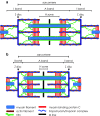SPontaneous Oscillatory Contraction (SPOC): auto-oscillations observed in striated muscle at partial activation
- PMID: 28510003
- PMCID: PMC5418397
- DOI: 10.1007/s12551-011-0046-7
SPontaneous Oscillatory Contraction (SPOC): auto-oscillations observed in striated muscle at partial activation
Abstract
Striated muscle is well known to exist in either of two states-contraction or relaxation-under the regulation of Ca2+ concentration. Described here is a less well-known third, intermediate state induced under conditions of partial activation, known as SPOC (SPontaneous Oscillatory Contraction). This state is characterised by auto-oscillation between rapid-lengthening and slow-shortening phases. Notably, SPOC occurs in skinned muscle fibres and is therefore not the result of fluctuating Ca2+ levels, but is rather an intrinsic and fundamental phenomenon of the actomyosin motor. Summarised in this review are the experimental data on SPOC and its fundamental mechanism. SPOC presents a novel technique for studying independent communication and coordination between sarcomeres. In cardiac muscle, this auto-oscillatory property may work in concert with electro-chemical signalling to coordinate the heartbeat. Further, SPOC may represent a new way of demonstrating functional defects of sarcomeres in human heart failure.
Keywords: Auto-oscillation; Cardiac muscle; SPOC; Sarcomere; Skeletal muscle.
Figures




References
Publication types
LinkOut - more resources
Full Text Sources
Miscellaneous

